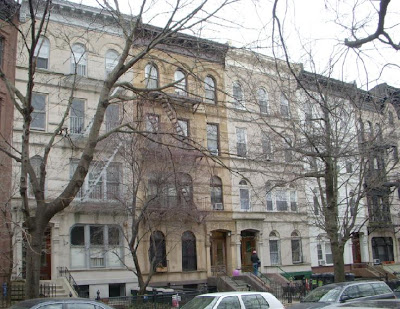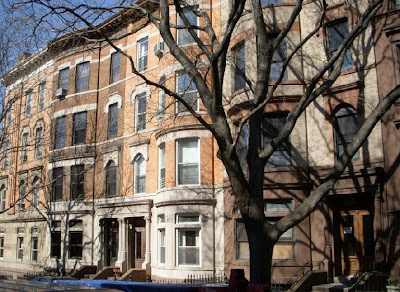Updated: the row at the northeast corner of 6th Avenue and 1st Street is not by Bonert.At the present time we have no documentary evidence regarding the
east side of 6th Avenue between Garfield Place and 1st Street. However, knowing what we now know about the work of prolific Park Slope builder Louis Bonert, we are almost certain that the entire blockfront facing 6th Avenue is by him.
The buildings at the southeast corner of 6th Avenue and Garfield Place are consistent with
Bonert's Neoclassical-style apartment houses. They are four story flat houses, fully faced with limestone over a brownstone basement, featuring full-height rounded window bays. The Garfield Place elevation is of "fancy brick" with limestone trim, and features rounded windows at the top story:
 6th Avenue & Garfield Place, southeast corner - unprotected
6th Avenue & Garfield Place, southeast corner - unprotected
The four-family flat houses feature paired classical entrances and "Greek ears" on upper story windows:
 271-273 6th Avenue - unprotected
271-273 6th Avenue - unprotected
The style changes mid-block, where the buildings continue in a row very much like
Bonert's Romanesque-inspired "Green Man" flat houses:
 277-279 6th Avenue - unprotected
277-279 6th Avenue - unprotected
Except these buildings, if indeed they are by Bonert, lack the characteristic terra cotta spandrel panels below the windows. Also the top-floor window arches employ a keystone, which is unusual for Bonert.
Also uncharacteristically, Bonert's usual "clustered columns" flanking the doorway have been reduced to a single Romanesque column in these buildings:
 281 6th Avenue - detail
281 6th Avenue - detail
The row concludes in a wonderful 8-family "double flat" apartment house featuring a rounded window bay overlooking the intersection.
 6th Avenue and 1st Street, northeast corner - unprotected
6th Avenue and 1st Street, northeast corner - unprotected
 6th Avenue and 1st Street, northeast corner - detail
6th Avenue and 1st Street, northeast corner - detail
So are these buildings by Bonert? At this time we can cite no documentary evidence supporting such a claim. However his hand seems quite clear to us. We would probably date these as "circa 1895", similar to the
Bonert row running westward from the northwest corner of 6th Avenue and 3rd Street.
The double flat at the southeast corner of 6th Avenue and Garfield Place features a highly distinctive cast- and wrought-iron fence about the areaway:
 6th Avenue and Garfield Place, southeast corner - detail
6th Avenue and Garfield Place, southeast corner - detail
We knew we'd seen this unusual fencing somewhere else in Park Slope, and with a bit of digging we found it. Indeed, the same fence is found at 427 3rd Street:
 427 3rd Street - detail
427 3rd Street - detail
427 3rd Street is just below 6th Avenue, on the north side of the street, in the middle of
a row confirmed to have been built by -- you guessed it -- Louis Bonert in 1895.
 New York Times, August 28, 1910, p. 10 ("Brooklyn's Apartment House Development Active on the Heights and Prospect Park")
New York Times, August 28, 1910, p. 10 ("Brooklyn's Apartment House Development Active on the Heights and Prospect Park")




















































